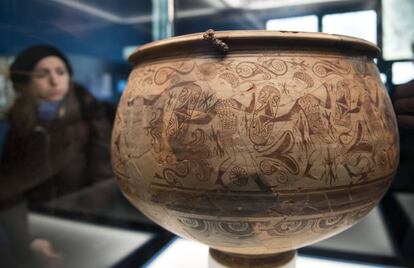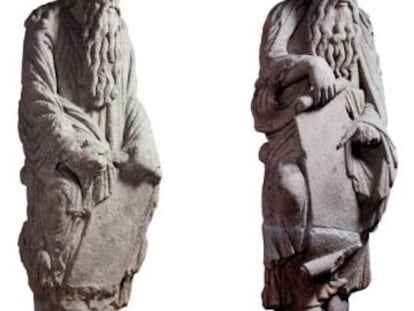The enigma of the Iberian warrior vase
New research sheds light on 2,000-year-old object found in Valencia in 1934, a masterpiece of Iberian art

The vase of the warriors, a masterwork of Iberian art, is still holding onto some of its secrets. But new research, the results of which can be seen until March in an exhibition at the Prehistory Museum of Valencia, sheds more light on the origin and meaning of the exceptional object, which is dated between the third and second centuries BC, and in terms of importance, is considered to represent the painting equivalent of the famed Lady of Elche sculpture.
In terms of artistic quality, detail, and sequence of the decoration there is nothing comparable to this piece
Jaime Vives-Ferrándiz, Prehistory Museum curator
The image painted on the large vase represents six horsemen and two infantrymen armed with falcatas (the curved sword used by the pre-Roman Iberians) and spears pursuing four other warriors who are fleeing on foot while looking back with concern and protecting themselves with shields. The motifs painted around the characters, mainly leaves and flowers, illustrate an outdoor setting.
The question that persists is whether a real battle is represented or a ritual confrontation. Archaeologists have said that it reflects some of the values – such as war and violence – of the elites of the old Iberian city-state of Edeta, the center of which was what is now the city of Llíria near the Mediterranean coast, where the vase was found in 1934.
“Weapons had a social value that was lost in other historical moments,” says Jaime Vives-Ferrándiz, one of the two curators of the exhibition “The Enigma of the Vase” and curator of the Prehistory Museum, where the vase has been since it was discovered 30 kilometers from Valencia. “Today people are not usually buried with a weapon, but that was the case in those times. They also depicted themselves with their weapons.”
The huge vessel (43 centimeters high and 52 centimeters wide) was probably never used for eating, but it is possible that it could have been used to drink something in social rites or celebrations, such as the change of season or an aristocrat’s entry into adulthood.

The work was found in the remains of a building that was initially considered an unimportant construction from the era, but that now, according to Helena Bonet, the museum director and also a curator of the exhibition, is now considered to be exceptional. It was probably a temple, featuring a well into which this and another dozen vessels – all featuring extraordinary paintings – were thrown, along with glasses, plates and a terracotta figure that appears to represent an ancestor. The pit was subsequently sealed up. All of the objects are typical of a large celebration banquet.
The set of images that decorate the pieces, some of which feature women in leading roles, is a window into the life of the Iberian aristocracy, who were lovers of music and dance and who were concerned about clothing and exhibiting their expertise in war.
In the vase of the warriors, two of the attackers hold swords with their left hands. “We do not have definitive conclusions, but it could be because that are boasting about their skill with weaponry,” says Vives-Ferrándiz.
There is no evidence that the painter of the vase of the warriors was a prolific artist, but the same person, or his workers, also created the other pieces found in the building. The proper names that appear on some vases – along with other phrases that are not translatable as well as other clues – lead researchers to deduce that the objects were gifts.
The work was found in the remains of a seemingly innocuous Edeta building now believed to have been a temple
Like the other vases found in the Edeta ritual well, that of the warriors had to be reconstructed, since it was probably broken after being thrown into the pit by its owners during celebrations. “The artistic quality of the vase of the warriors surpasses that of any other indigenous pottery in the western Mediterranean. The pottery execution is exceptionally small and barely three millimeters thick. In terms of artistic quality, detail, and sequence of the decoration there is nothing comparable to this piece,” explains the curator of the museum.
There is also a mystery surrounding the fate of Edeta, one of the main Iberian city-states, whose dominion extended from the River Mijares in Castellón to the Júcar in Valencia. Archaeological analysis suggests that it was destroyed, perhaps by Roman soldiers, at the beginning of the second century BC, perhaps a generation or two after the vase of the warriors was created. “We know it was a violent episode because things were left there, there was no plan to abandon the site,” says Vives-Ferrándiz. “In other cases we can see when people have moved, but not here.”
English version by Debora Almeida.
Tu suscripción se está usando en otro dispositivo
¿Quieres añadir otro usuario a tu suscripción?
Si continúas leyendo en este dispositivo, no se podrá leer en el otro.
FlechaTu suscripción se está usando en otro dispositivo y solo puedes acceder a EL PAÍS desde un dispositivo a la vez.
Si quieres compartir tu cuenta, cambia tu suscripción a la modalidad Premium, así podrás añadir otro usuario. Cada uno accederá con su propia cuenta de email, lo que os permitirá personalizar vuestra experiencia en EL PAÍS.
¿Tienes una suscripción de empresa? Accede aquí para contratar más cuentas.
En el caso de no saber quién está usando tu cuenta, te recomendamos cambiar tu contraseña aquí.
Si decides continuar compartiendo tu cuenta, este mensaje se mostrará en tu dispositivo y en el de la otra persona que está usando tu cuenta de forma indefinida, afectando a tu experiencia de lectura. Puedes consultar aquí los términos y condiciones de la suscripción digital.
More information
Archived In
Últimas noticias
Half of Scotland is in the hands of 420 property owners
Reinhard Genzel, Nobel laureate in physics: ‘One-minute videos will never give you the truth’
Pinochet’s victims grapple with José Antonio Kast’s rise in Chile
From digital curfews to blocking apps: How technology experts protect their children online
Most viewed
- Pablo Escobar’s hippos: A serious environmental problem, 40 years on
- Reinhard Genzel, Nobel laureate in physics: ‘One-minute videos will never give you the truth’
- Why we lost the habit of sleeping in two segments and how that changed our sense of time
- Charles Dubouloz, mountaineering star, retires at 36 with a farewell tour inspired by Walter Bonatti
- The Florida Keys tourist paradise is besieged by immigration agents: ‘We’ve never seen anything like this’











































